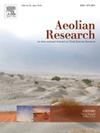Combining modeling and isotopic signatures to track Aeolian dust from source to sink in the Wasatch Front, Utah, USA
IF 3.4
3区 地球科学
Q2 GEOGRAPHY, PHYSICAL
引用次数: 0
Abstract
Dust events are tracked from source to sink using geochemical/isotopic tracers, dust emission and transport modeling, or remote sensing, but these tools are rarely used together. To test the utility of combining multiple dust tracking methods, we used three Wasatch Front (Utah) dust events from August 2009, May 2020, and September 2020 to compare source apportionment estimated by the Community Multiscale Air Quality (CMAQ) model and strontium isotope (87Sr/86Sr) ratios. The Wasatch Front is impacted by atmospheric particulate matter (PM) from local urban sources and regional playas including Sevier Dry Lake, Great Salt Lake (GSL), and the GSL Desert. CMAQ modeling of the August 2009 event showed dust emission and transport from multiple playa sources to the Salt Lake City measurement site as wind patterns changed during the storm. The predicted mix of sources was consistent with the measured 87Sr/86Sr ratio of 0.71217 on the PM10 filter collected during the event. Modeling of the May 2020 period showed a consistent meteorological pattern that carried dust from the Sevier Dry Lake area toward the Provo measurement site, consistent with the measured 87Sr/86Sr ratio of 0.71015. Modeling of the September 2020 period indicated a major dust event with complex wind patterns that changed during the event, resulting in relatively small amounts of dust from GSL Desert being transported to the Provo site. No emissions from Sevier Dry Lake were predicted to reach the site during the September event, suggesting GSL Desert contributions were mixed with local dust with a lower 87Sr/86Sr ratio to produce the measured value of 0.71097. Results from the three dust events demonstrate the benefits of combining CMAQ emission and transport modeling with isotopic data from PM10 filters to better characterize dust source-to-sink behavior in Utah, and illustrate the potential for application in other arid regions.

结合模拟和同位素特征追踪美国犹他州瓦萨奇前线从源头到汇的风沙
利用地球化学/同位素示踪剂、粉尘排放和运输模型或遥感,从源头到汇跟踪粉尘事件,但这些工具很少同时使用。为了验证多种粉尘跟踪方法组合的有效性,我们使用了2009年8月、2020年5月和2020年9月在犹他州Wasatch Front发生的三次粉尘事件,比较了社区多尺度空气质量(CMAQ)模型和锶同位素(87Sr/86Sr)比率估算的源分配。瓦萨奇前沿受到来自当地城市和区域游乐区的大气颗粒物(PM)的影响,包括塞维尔干湖、大盐湖(GSL)和GSL沙漠。2009年8月事件的CMAQ模型显示,随着风暴期间风型的变化,从多个playa源到盐湖城测量点的粉尘排放和运输。预测的混合源与事件期间收集的PM10过滤器上测量到的87Sr/86Sr比值0.71217一致。对2020年5月期间的建模显示,一种一致的气象模式将沙尘从塞维尔干湖地区带到普罗沃测量点,这与测量到的87Sr/86Sr比值0.71015一致。对2020年9月期间的建模表明,一次重大的沙尘事件发生了复杂的风型,在此事件期间发生了变化,导致GSL沙漠中相对少量的沙尘被运送到普罗沃站点。在9月份的事件中,预计没有来自塞维尔干湖的排放物到达该地点,这表明GSL沙漠的贡献与87Sr/86Sr比较低的当地尘埃混合在一起,产生了0.71097的测量值。三个沙尘事件的结果表明,将CMAQ排放和输送模型与PM10过滤器的同位素数据相结合,可以更好地表征犹他州的沙尘源-汇行为,并说明在其他干旱地区应用的潜力。
本文章由计算机程序翻译,如有差异,请以英文原文为准。
求助全文
约1分钟内获得全文
求助全文
来源期刊

Aeolian Research
GEOGRAPHY, PHYSICAL-
CiteScore
7.10
自引率
6.10%
发文量
43
审稿时长
>12 weeks
期刊介绍:
The scope of Aeolian Research includes the following topics:
• Fundamental Aeolian processes, including sand and dust entrainment, transport and deposition of sediment
• Modeling and field studies of Aeolian processes
• Instrumentation/measurement in the field and lab
• Practical applications including environmental impacts and erosion control
• Aeolian landforms, geomorphology and paleoenvironments
• Dust-atmosphere/cloud interactions.
 求助内容:
求助内容: 应助结果提醒方式:
应助结果提醒方式:


